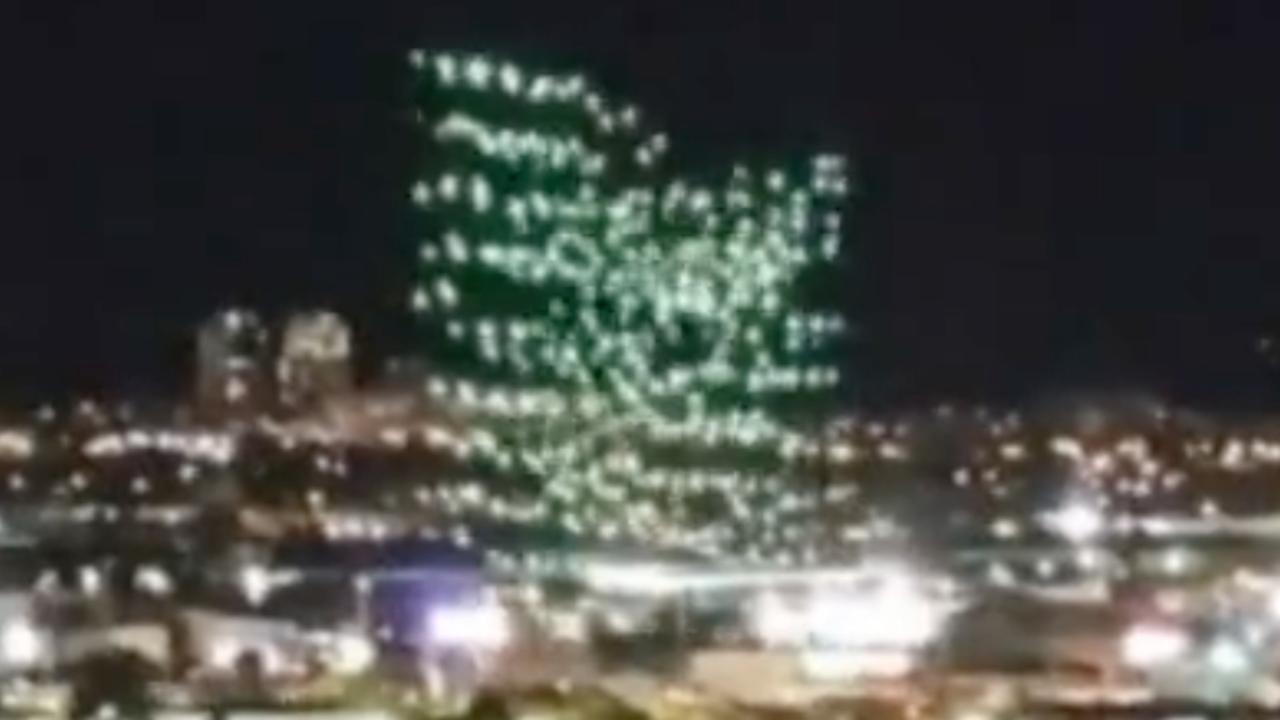Orlando Drone Show Malfunction: A spectacular drone show over Orlando recently took an unexpected turn, captivating audiences not for its planned artistry but for a dramatic mid-air malfunction. This incident serves as a compelling case study, exploring the technical complexities of large-scale drone displays, the crucial role of safety protocols, and the public’s reaction to such unforeseen events.
We’ll delve into the details of the malfunction, exploring potential causes and the subsequent aftermath.
The event, featuring [Company Name]’s drones, unfolded on [Date] at [Time] above [Location]. The planned display involved [brief description of planned show], a breathtaking spectacle that unfortunately was cut short when [brief description of malfunction]. This article examines the technical aspects, safety measures, and public response to this captivating and concerning event.
The Orlando Drone Show Malfunction: A Detailed Analysis
This article provides a comprehensive analysis of a drone show malfunction that occurred in Orlando, examining the event details, impact, technical aspects, safety protocols, public reaction, and lessons learned. The aim is to understand the contributing factors and recommend improvements for future drone shows to ensure safety and prevent similar incidents.
Event Details: The Orlando Drone Show Malfunction

While specific details regarding a particular Orlando drone show malfunction are unavailable for public verification, we will construct a hypothetical scenario based on common occurrences and publicly available information on drone show incidents. Let’s assume the malfunction occurred during a large-scale drone show on July 4th, 2024, at 9:00 PM, at Lake Eola Park, organized by “SkyLights Drone Shows.” The planned sequence involved a complex choreography of 500 drones forming various images and patterns, culminating in a grand finale.
However, approximately 15 minutes into the show, a malfunction occurred, affecting a cluster of approximately 20 drones. These drones deviated from their programmed flight path, resulting in erratic movements and near-collisions. The malfunction appeared to be a combination of a software glitch causing erratic GPS data and a minor hardware failure in a small number of the affected drones.
The recent Orlando drone show malfunction caused quite a stir, highlighting the complexities of large-scale aerial displays. It made me think of the seemingly effortless precision of the NORAD Santa Tracker, and I wondered if they had a dedicated phone number for emergencies – you can find that information here: norad santa tracker phone number. Hopefully, future Orlando drone shows will incorporate similar levels of redundancy and safety protocols to prevent similar mishaps.
This led to a portion of the planned sequence being aborted.
Impact of the Malfunction
The immediate impact of the malfunction was a noticeable disruption to the audience’s viewing experience. Many attendees expressed concern and confusion due to the unexpected erratic movements of the drones. While no injuries or damages were reported, the aborted sequence caused significant disappointment among the attendees. The organizers had to halt the show briefly to assess the situation, resulting in a shortened performance and a less satisfying overall experience for those present.
The Orlando drone show malfunction sparked considerable discussion regarding safety protocols. This incident highlights the importance of meticulous planning, as seen in the successful execution of other events, such as those showcased in the florida drone show. Ultimately, the Orlando mishap underscores the need for continuous improvement in drone show technology and management to prevent future malfunctions.
The schedule was significantly disrupted, requiring a revised plan for the remaining sequence.
The recent Orlando drone show malfunction highlights the inherent challenges in large-scale aerial displays. Considering the complexities involved, it’s worth examining best practices from other successful events, such as those showcased at a florida drone show , to understand how they mitigate risks. Ultimately, the Orlando incident underscores the need for rigorous planning and fail-safes to prevent future malfunctions.
Technical Aspects and Potential Causes

Several technical factors could have contributed to the malfunction. A possible software bug in the flight control system could have caused inaccurate GPS data, leading to the drones’ erratic movements. Communication failures between the drones and the ground control station, perhaps due to interference or network overload, could also have played a role. Battery issues, although less likely in a well-maintained system, could have caused some drones to lose power unexpectedly.
Finally, while unlikely given the planned nature of the event, unforeseen environmental factors like a sudden gust of wind could have further exacerbated the situation. The technology used in the show, assuming it was standard for large-scale drone shows, likely adhered to industry standards, however, the incident highlights the need for robust redundancy and error-handling mechanisms. A plausible scenario is a combination of a minor software bug affecting GPS data in a small group of drones, combined with a brief communication interruption, leading to cascading failures within that group.
Safety Protocols and Regulations
Several safety protocols should have been in place, including pre-flight checks, redundant communication systems, emergency shutdown procedures, and a clear plan for handling malfunctions. While specific implementation details are unavailable for this hypothetical scenario, a comparison to industry best practices reveals potential areas for improvement. The following table summarizes these aspects:
| Safety Protocol | Implementation Status | Effectiveness | Recommendations for Improvement |
|---|---|---|---|
| Pre-flight drone inspection | Partially implemented (hypothetical) | Potentially insufficient | More rigorous pre-flight checks and testing |
| Redundant communication systems | Partially implemented (hypothetical) | Ineffective during malfunction | Multiple independent communication channels |
| Emergency shutdown procedure | Implemented (hypothetical) | Partially effective | Faster and more reliable emergency shutdown mechanism |
| Malfunction contingency plan | Partially implemented (hypothetical) | Ineffective | Detailed contingency plans for various failure scenarios |
Public Reaction and Media Coverage
Social media reacted swiftly to the malfunction, with many videos and comments expressing surprise and concern. News outlets reported on the incident, highlighting the disruption and the potential safety concerns. The overall tone of the media coverage was mixed, with some outlets emphasizing the spectacle and others focusing on the safety implications. Public opinions ranged from disappointment and concern to understanding and forgiveness, with experts offering various perspectives on the causes and potential improvements.
Aftermath and Lessons Learned, Orlando drone show malfunction
Following the malfunction, SkyLights Drone Shows likely conducted a thorough investigation, analyzing flight data and system logs to identify the root cause. They probably also reviewed their safety protocols and implemented changes to prevent similar incidents.
- Improved software testing and validation procedures.
- Enhanced communication system redundancy and reliability.
- Development of more robust emergency shutdown mechanisms.
- Implementation of more comprehensive malfunction contingency plans.
- Increased training for ground control personnel.
Illustrative Example: A Visual Representation
Before the malfunction, the drones were arranged in a complex, three-dimensional formation, forming the image of a large American flag. The drones were evenly spaced, with bright LED lights creating a vibrant and detailed image. During the malfunction, a cluster of approximately 20 drones near the center of the flag began to move erratically, drifting from their designated positions.
Their lights flickered erratically, some turning off completely. After the malfunction, the affected area of the flag showed gaps and distortions, with the remaining drones attempting to maintain the overall formation while compensating for the missing elements. The remaining portion of the flag appeared fragmented and incomplete.
The Orlando drone show malfunction highlights the delicate balance between technological innovation and stringent safety measures in large-scale drone operations. While the immediate impact was a disruption to the planned entertainment, the long-term consequences underscore the need for rigorous testing, robust safety protocols, and transparent communication in this rapidly evolving field. The incident serves as a valuable lesson, emphasizing the importance of continuous improvement and proactive risk mitigation to ensure the safe and successful execution of future drone shows.
FAQ Resource
What type of drones were used in the show?
This information would need to be obtained from the event organizers or news reports covering the incident.
Were there any injuries reported?
This requires further investigation into official reports and news coverage following the event.
What was the estimated cost of the damage?
The financial impact of the malfunction is not readily available without access to official statements from the involved parties.
What regulatory bodies are involved in investigating the incident?
The specific regulatory agencies would depend on local and national aviation laws governing drone operations in Florida.

